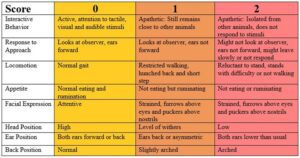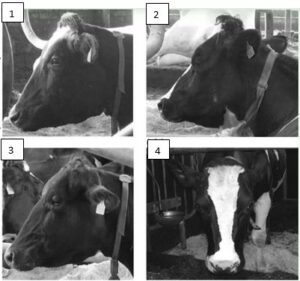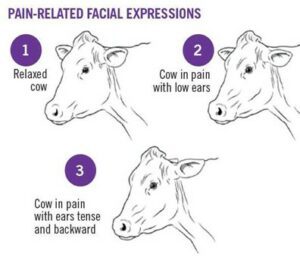It is fundamentally important to address pain for the animal’s benefit and production efficiency. Noticing early physiological and behavioral changes can help producers recognize problems before the pain becomes chronic or debilitating. For example, when calves are dehorned and in pain, they will flick their ears and shake their heads repeatedly. Noticing these behavioral changes, along with redness and warmth of horn buds, gives producers the opportunity to manage calf pain and decrease the risk of future health challenges, like scours. Another example is catching early signs of digital dermatitis before it becomes clinical digital dermatitis. A cow with early digital dermatitis will change her gait slightly as an indicator of pain. A producer can recognize that the animal is in pain and trim treat the infection before it becomes clinical digital dermatitis. It can be difficult to know when cows are experiencing pain as cows cannot express how they feel. It is important to use available tools like the cattle pain scale to help detect changes associated with pain. Listed below are six factors to consider when scoring pain. Sick animals should be isolated, placed in clean, well-bedded areas with individual food and water supplied. They should be observed frequently using the pain scale. Prompt recognition and treatment of diseases are essential to reduce pain in farm animals.
Prevention
Many causes of pain in animals arise from diseases. Most diseases are preventable by vaccination. Vaccination should be a major component of the farms’ herd and flock’s health programs and is a cost-effective means of preventing diseases such as pneumonia and the pain associated with that disease. Other major causes of pain arise from the housing conditions in which we keep our stock, particularly dairy cattle. Many physical injuries are caused by inadequate numbers of comfortable cubicles, narrow pastures with tight turns, and slippery floors.
The Four S’s of Pain Management:
- Suppress – When possible, make changes so a procedure is no longer necessary. In the case of dehorning, the adoption of polled genetics will eventually make dehorning obsolete.
- Substitute – Refine how the procedure is performed to reduce pain if you can. For horn removal, use disbudding versus dehorning by performing the procedure at a younger age before the horn bud has attached to the underlying bone. Changing calf handling techniques and providing proper restraint also can reduce stress.
- Soothe – Using analgesics to reduce pain before a procedure starts. Administrating a local cornual nerve block with lidocaine before dehorning will help reduce pain caused by the procedure.
- Supplement – Back up the initial pain mitigation with a longer-acting analgesic. Veterinary-prescribed meloxicam given at the time of dehorning in addition to lidocaine can minimize the chronic inflammatory pain caused by the procedure for at least 48 hours. Together, they will help control different parts of the pain pathways.




